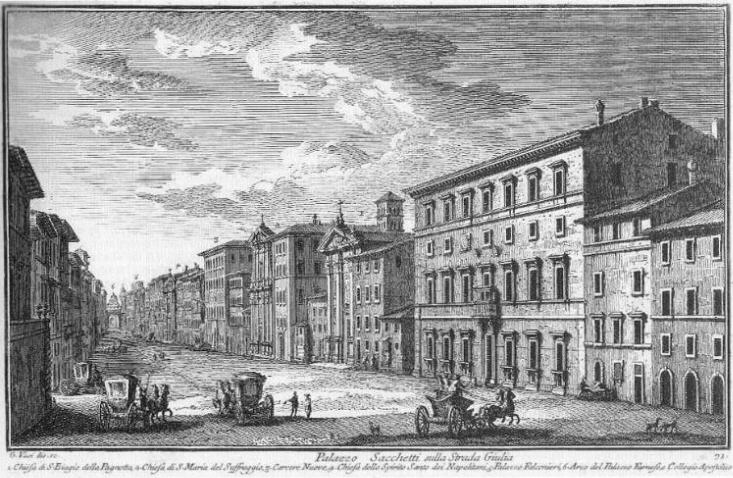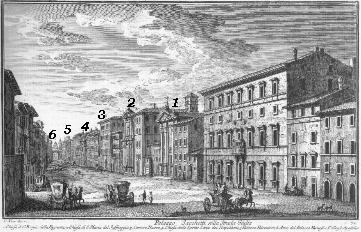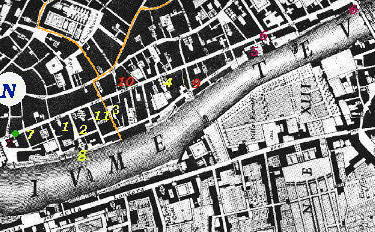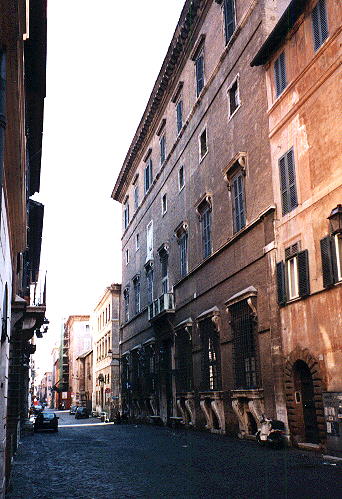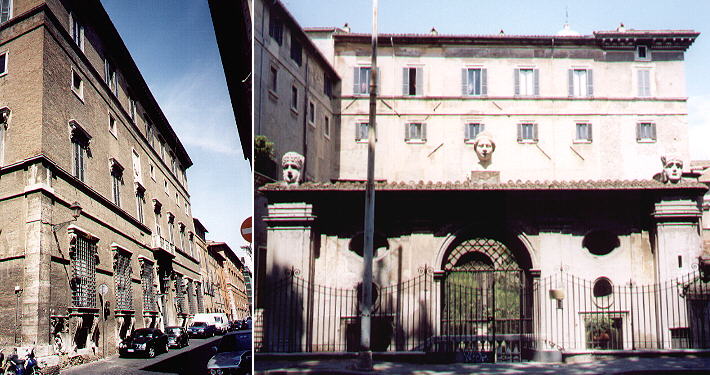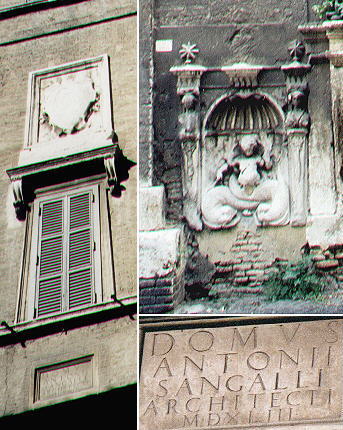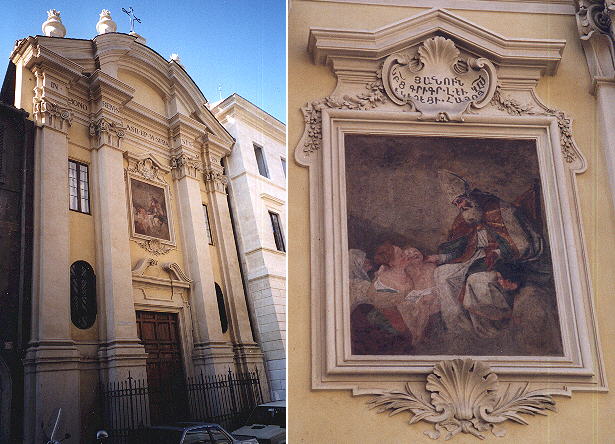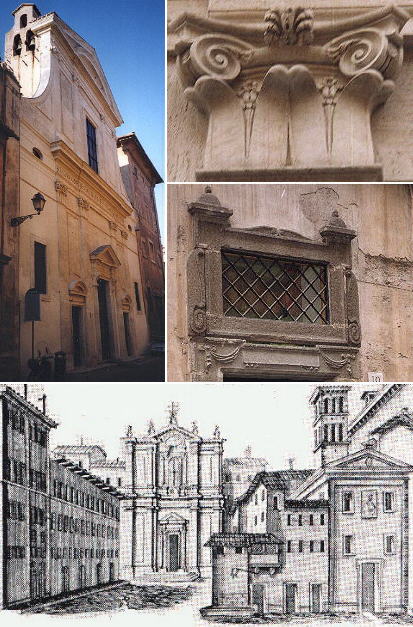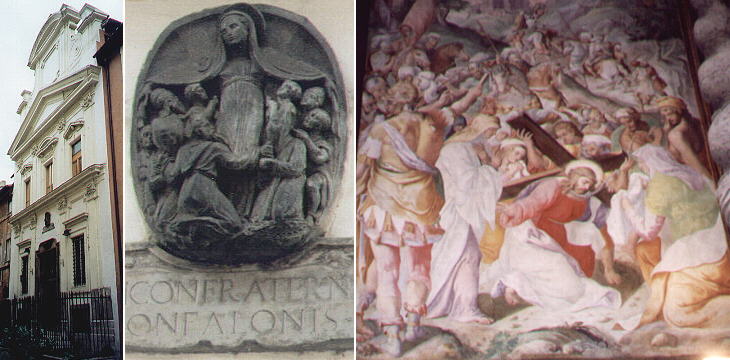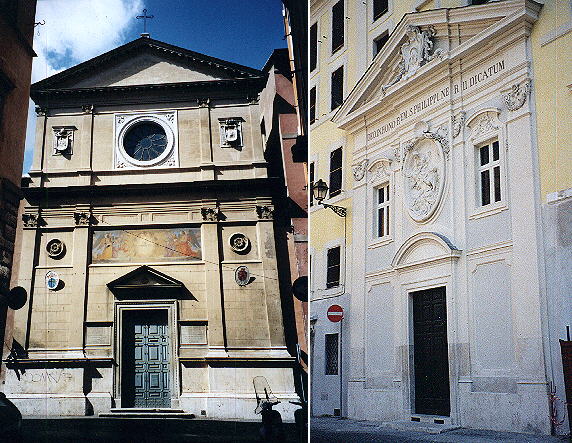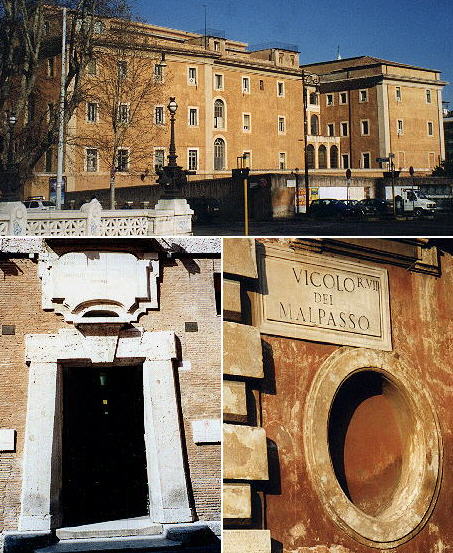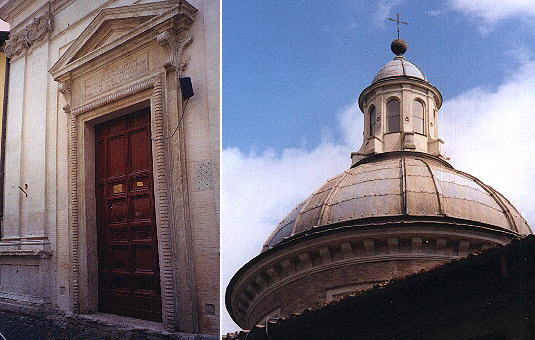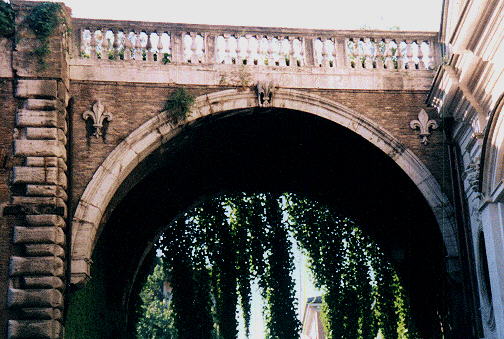  Palazzo Sacchetti sulla Strada Giulia (Book 4) (Map C2) (Day 7) (View D4) (Rione Ponte) and (Rione Regola) In this page:
Julius II is the Pope to whom Strada Giulia owes its name. Medieval
Rome layout was very much influenced by the few families (Orsini, Colonna,
Frangipane) who had transformed Roman buildings into fortresses with their
followers living in small houses clustered around, with very little
communication between one area and the other. With the progressive growth
of the Papal supremacy over these families and with the aim of bringing
Rome to the level of the northern cities of Italy where rational city layouts
had been developed, Alexander VI started opening straight streets (Via
Alessandrina) in the medieval net. Julius II with Via Giulia gave to Renaissance
Rome its first high street by linking Ponte S. Angelo
with Ponte Sisto. The view is taken from the green dot in the small 1748 map here below.
In the description below the plate Vasi made reference to: 1) S. Biagio della Pagnotta;
2) S. Maria del Suffragio; 3) Carcere Nuovo; 4) Spirito Santo dei Napoletani;
5) Palazzo Falconieri; 6) a - Arco del Palazzo Farnese and b - Collegio Apostolico. 5) and 6b) are shown in other pages.
The small map shows also 7) Palazzo Sacchetti; 8) S. Anna dei Bresciani; 9) S. Eligio degli Orefici; 10) S. Filippo Neri; 11) Oratorio del Gonfalone.
The dotted orange line in the small map delineates
the border between Rione Ponte (left) and Rione Regola (right).
The center of Roman life having shifted towards Via del Corso and traffic being routed away make today Via Giulia a very exclusive and posh living area. Vasi's plate enlarges and shortens Via Giulia to show all the churches and palaces, so the view seems very different, but by walking along Via Giulia one finds that almost all the buildings quoted by Vasi are there with very little alterations.
Palazzo Sacchetti is a severe but elegant palace: it is not clear
whether it was built by Sangallo the younger for his own living (as the
inscription suggests) or that it was built slightly later, on the house of Sangallo. It was acquired in 1576 by the banker
Tiberio Ceuli from Pisa who was considered the richest banker in Rome. His son however was soon bankrupt and forced to sell the building which was eventually bought by the Sacchetti from Florence.
The Ceuli built the little fountain at the corner of the palace, while the erased coat of arms at the center of the fašade was of Paulus III the Maecenas of Sangallo.
In 1660 Carlo Rainaldi built a fine nymphaeum in the garden which is clearly visible in the Great View of Rome. The garden had direct access to the river,
today it is almost strangled by the new street along the river (Lungotevere) built at a higher level to prevent floods.
The little church of S. Biagio is called "della Pagnotta" (of the round loaf) because on the day of S. Biagio (Feb. 3) little round loaves are distributed to children. The church was almost thoroughly rebuilt in 1730 by Giovanni Antonio Perfetti. It is also called S. Biagio degli Armeni, because it serves the Armenian community of Rome, hence the use of the Armenian alphabet in the script on the fašade (click here for a list of national churches in Rome). S. Maria del Suffragio e S. Anna dei Bresciani
Suffragio (suffrage) is a reference to the prayers for the souls of the dead which were the aim of the confraternity which erected the church in 1669. Carlo Rainaldi suggested an elliptical shape, but the confraternity preferred a more traditional and sober design. Between S. Biagio and S. Maria del Suffragio there was a little street leading to S. Anna dei Bresciani. Brescia, a Venetian town between Milan and the Garda Lake, was and still is very rich and pious. The block of houses between S. Maria del Suffragio and the river belonged to the association of the inhabitants of Brescia in Rome. S. Anna dei Bresciani, with an interesting fašade by Carlo Fontana was pulled down to build the new quays. The plate at the bottom (M. G. Rossi) shows S. Anna and on the right S. Biagio. Some details of the monastery adjoining the church are still visible in the new buildings erected on the lungotevere.
A little church has existed on this site since the VIIIth century, but the current oratory was built in the XVIth century.
The upper part of the fašade was added in the XVIIth century by Domenico Castelli. The confraternity owning the oratory was known for
the organization of processions and other religious ceremonies. Their representations of Christ's Passion were so realistic that the Popes had to stop them as they ended in attacks against the Jews.
The members wore a white habit and their heads were covered by a blue hood; the relief above the entrance shows a member of the confraternity to the right of the Virgin Mary.
Gonfalone means standard/banner and it refers to the fact that in the XIVth century the members of the brotherhood used to raise the standard of the Pope (at the time in Avignon) to support his role as sovereign of Rome. S. Spirito dei Napoletani e S. Filippo Neri
At the beginning of Via Giulia there is the church of the Florentines
(S.
Giovanni) and a few steps farther the church of the Neapolitans (click here for a list of national churches in Rome). It
was restored in the XIXth century and it bears the coats of arms of Pius
IX and of the King of Naples (or of the Two Sicilies) of the Bourbon family.
Here was buried (until 1984) the only daughter of Francesco II the last King of Naples
(she died when she was a child). Both the Pope and the King of Naples were
accustomed to losing their kingdom and then regaining it. In 1848 Pius
IX sought refuge in the Neapolitan fortress of Gaeta and stayed there
under the protection of the King of Naples until the French regained control
over Rome fighting against Garibaldi. In 1861
Francesco II left Gaeta (the fortress fell on February 14, and on March 20
Civitella del Tronto, the last stronghold loyal to him, surrendered) and came in exile
to Rome with the hope to return one day to Naples. But in 1870 Pius IX
lost his kingdom too. The Italy of the Seven States (Savoia, Lombardo-Veneto,
Parma, Modena, Tuscany, Papal State and
Kingdom of the Two Sicilies) was over.
The prison of Rome was in Tor di Nona (opposite Castel S. Angelo) and had a scaring reputation. Innocentius X built a new prison (Carceri Nuove) which is today very nice to look at. However for those who had to enter the building for being jailed it was not that nice. A side street leading to Via Giulia at the point where the prison is, was rightly called Vicolo del Malpasso (passo=step mal=bad, unfortunate).
The little church of the goldsmiths' guild was initially designed by Raphael and because of this it was spared by the quaying of the Tiber. The nearby church of S. Niccol˛ degli Incoronati was pulled down. S. Eligio is also honored by the blacksmits in S. Eligio dei Fabbri (click here for a list of churches belonging to a guild).
Via Giulia ends at the Collegio
Ecclesiastico, but before that it passes between two very important
palaces: Palazzo Farnese and Palazzo
Falconieri, the main fašade of which is seen from the river. The side
on Via Giulia has two interesting hawk heads (see background) Falconieri
meaning hawkers. The Farnese had on the other side of the river their Villa
(la Farnesina). Although nearby Ponte Sisto provided
an easy passage to Trastevere, they built an arch over Via Giulia to the
river bank, where by boat they could reach their Villa.
Next plate in Book 4: Palazzo Corsini Next step in Day 7 itinerary: Chiesa di S. Lucia del Gonfalone Next step in your tour of Rione Regola: S. Caterina alla Ruota You have completed your tour of Rione Ponte!
Go
to |
All images © 1999 - 2003 by Roberto Piperno. Write to romapip@quipo.it
